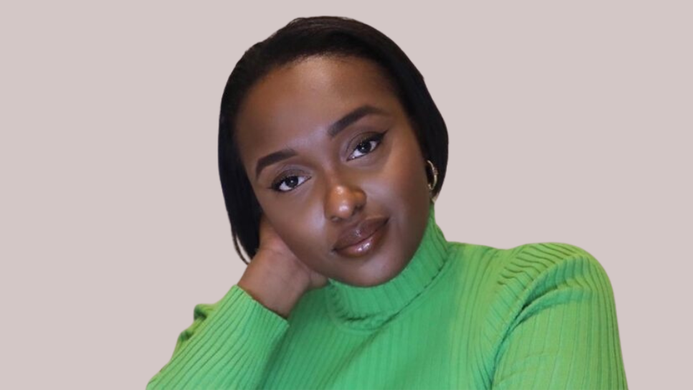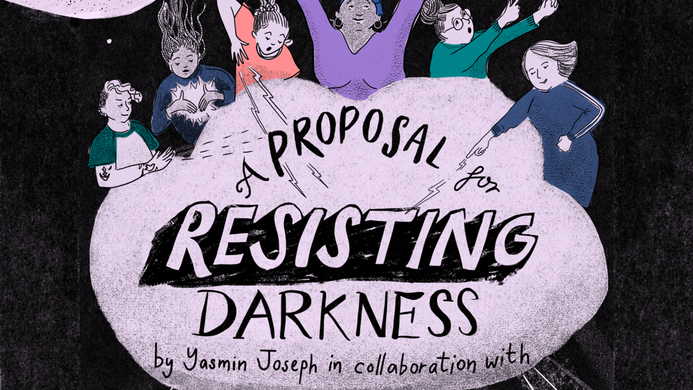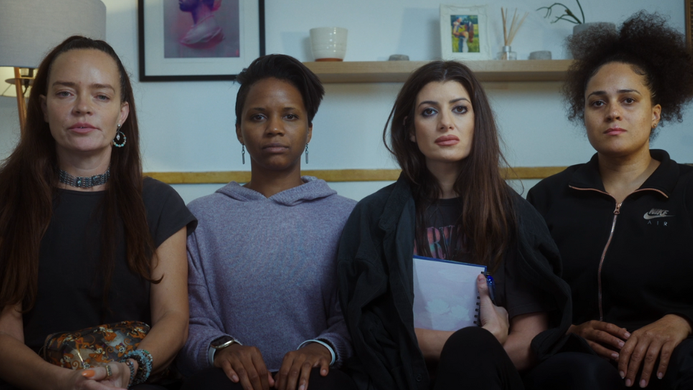
An interview with the writer of A Proposal for Resisting Darkness
Our audio-drama A Proposal for Resisting Darkness was adapted from a play created by Yasmin Joseph and a group of women at HMP Downview, a prison and young offender institution (YOI) for women aged 18 and over. The play was the outcome of a series of workshops which Clean Break held at the prison.
The theatre workshops and residencies which we bring into prisons create positive change in women’s lives, helping participants move forward, beyond their experiences of criminalisation. Find out more about our work in prisons here, and read more about the benefits of art in criminal justice settings on the National Criminal Justice Arts Alliance website.
The audio adaptation of A Proposal for Resisting Darkness was first played on National Prison Radio, which broadcasts into prison cells across England and Wales 24 hours a day, 7 days a week. Before the play aired, the playwright Yasmin was interviewed by one of their presenters. In this interview, she gave insight into the writing process, working with HMP Downview Theatre Company, and seeing the play be performed at the prison. Read their interview below:
You can listen to the full play on Clean Break’s Knowledge Hub here.
Presenter: Hi Yasmin, thank you so much for joining us today.
Yasmin: Hi, thank you so much for having me.
P: You're more than welcome. I would just like to ask you a few questions about the play, because it really interested me, and I've actually done some work with Clean Break, I felt it opened a new story for me. I always wanted to find out a bit more about it, and now this has come up, I was so excited to do this with you today.
So my first question for you today, is what was the first meeting like with the women in Downview? Did they come in and already have ideas about what they wanted you to do with the play? What was the process?
Y: That's a really good question, the way that we started the process was by kindly, gently moving forward into it. What was helpful for us to know was what everyone was interested in, and what their voices were like. We came in with a clear idea that we wanted to do something that included magical realism. Something that would encourage us to be really imaginative, and to push the boundaries of the story we were going to tell.
We used images and exercises where we would create a soundscape of what that place might sound like, or create short scenes based on what those images have prompted within us, like “what is a conversation we can imagine taking place in this location?” Then we'd make characters, and we spoke about what would happen if we introduced some of those characters into some of these places that we were exploring.
It became a process of gently adding more bricks until we finally found something that we wanted to make. But there was lots of playing, getting to know each other and sharing our interests, so that I could go away and narrow that down into what our play was going to be.
P: Did the play relate to the women's backgrounds, life or experience?
Y: We had lots of conversations and did lots of exercises to work out what the common interests we shared were. One of the things that came up as a strand that we wanted to follow was the idea of resistance, and what that could look like within all of us.
Resistance can be many things, it can be joy, it can be imagination, but we all spoke about the many modes of survival. All of the artists were really insightful about the different ways that they recharge themselves, that they find hope. I think what we were trying to do is take all of those different ways of surviving, different ways of existing and pushing yourself forward, and trying to elevate them into something that felt magical and a few inches above the ground, in terms of reality. All of the artists were invited to offer locations or scenarios they were interested in, and all of these were in some way linked to a part of their personal resistance.
My job was to then go away and be like, “how can I honour as much of what I found in the room”. It wasn’t so much about me coming in and telling a story, it was about me coming in and listening to the voices in the room, and finding a way to find a play that would hold as much of that as possible. Which is why it jumps between loads of locations, and it has lots of conversation, because that's what the process felt like. I definitely feel like my job and my mission was to make sure that the heart of what was behind what they shared was baked into the story that we made.
A good thing about magical realism and making things fantastical is that you don't have to put yourself in it, you can present something that you care about, but you can be protected by the form it takes place in. You don't necessarily have to overshare, you can have an idea about what it is you want to share, but it can be shaped by the way it is presented.
P: That's brilliant that everybody could pick a piece from their own experiences. My next question today is, did the women have any experience before they did the acting or writing?
Y: It was interesting because the women that we're working with are all incredibly creative. Some of them were writers, some of them had done other theatre projects, and what we were keen to establish in our process was to try something that they hadn't done before. If people had written pieces that were autobiographical then we encouraged them to think about what new characters they could imagine. And how could they transfer some of those experiences and turn them into something new for the work we were making.
Everyone had their own creative interests, we also had people who were interested in the set design side of things and costume, so they had some influence in how that manifested in our show. But what we were keen to do was to establish a way of working as a company, so we sat down and we were like, “what do we know, we're all interested in making outside of this room, but when we're here together, what do we want to make, and what is our way of working?” I think just like the play establishes like a list, and they do it as a collective, about how they're going to resist, we sat down as a group, and we established a set of guidelines for how we wanted to work together.
They gave me really helpful notes about what to go away and tweak or how to get closer to the intention of some of the things they wanted to share. It was a constant back and forth, so I think we all learnt loads from working with each other in that process.
P: What message did the HMP Downview Theatre Company want to put across in the play? I thought it was something to do with the darkness, trying to overpower the women. The women were like, in the end: “We're not letting this happen. We are powerful women.” Can you explain that, please?
Y: Yeah, I think your interpretation of it is beautiful. Our intention when making the work was that every person should listen to it and take something different from it.
I think one of the things that you tapped into was the idea that the play is supposed to speak to our individual strengths, and these strengths are deep down. Sometimes they can be quiet in painful, difficult times. But it's about tapping into them and remembering the wealth of resource and power that we have within ourselves. That's not always something other people can see, but it's something that we need to be aware of.
I think lots of the things we spoke about, like creativity and empathy, these are things that we can't necessarily touch or see in the way that people might expect, but they're present and they're big ways of connecting with other people. I think an undertone within it as well was sisterhood, people going through similar struggles, finding ways to reach across and understand each other and get each other through difficult times.
P: My next question for you today, (without giving too much away this is) - What was your favourite part of the play?
Y: It's hard to pick a favourite but I know the one that was most challenging. We had a list of locations that the artists in our group said that they would like to include within the play. One of them was in the clouds, and one of them was in the human body and I remember thinking “how on earth am I going to make this happen?”
I think that's a moment that excited me a lot within the play, primarily because it was quite hard to achieve but once we got there, it really highlighted how imaginative we had been, and how far we'd pushed ourselves to be really experimental with how we told the story.
Also, thinking about the women within the world of our play, what it means to step inside a body and to be as close to the soul of that person’s story, felt really exciting and truthful. So I feel like that was one of my favourite moments - but generally, I enjoyed all of the different elements, because each bit had something that one of the artists had contributed.
P: What feedback did you get from the women?
Y: It's important to point out that we did two versions of the show. We did a performance that was performed live at HMP Downview, and we've also now made a recorded version.
I think what has been really clear is that although the voices might be different in the recorded version, the essence of the people we made the show with is still so powerful, and that's because their imprint on the work was completely huge. It was shaped by them.
The feedback we got from the artists we worked with was mainly that it was so nice to be really playful and experimental. Every time we'd have our sessions, we'd come in and we check in at the beginning and say how our day felt at that moment. By the end, we always landed somewhere completely different and that was because I think we'd all been so generous, and they'd been so generous with their minds and with what they contributed to the room. It always felt like we left that room with so much to think about until we met again.
P: What was the reaction in HMP Downview when the play was first performed there?
Y: It was such an interesting time to perform because it was in a period of COVID where there had been quite a lot of isolation. I think to come together and to be in a room, and that room being a place where we then transported us... to the clouds, into a body, into the ocean... I think the feeling in that room is really kind of fizzy. Everyone was energised and excited by it and it really felt like a triumph to have seen the artists we worked with command the space in that way. They transformed it and they put so much of themselves into it that everybody left inspired by what they shared.
A lot of the feedback we got from that was about people questioning what parts of the proposal for resisting darkness apply to them, or what parts of that proposal they might have forgotten, and they've been reminded to tap into when things get difficult. So, I think what was exciting for us is that everybody left thinking about how they resist and how they survive, and what they have within them that they can continue to tap into - that felt really exciting.
P: Finally - What are your parting words to listeners of the play?
Y: My parting words would be to approach the play with the openness with which it was made, and to allow yourself to sink into it and to fully follow the journey with imagination and with an open heart. Also, to take whatever bits of their resistance that apply to you and to exercise them fully. To be reminded that creativity is something that is entirely yours and can never be taken, and can be such a freeing thing.
So, I would encourage everybody to enjoy it and revisit it and create their own proposal for resisting darkness, and I hope that's an inspiring and encouraging thing.

